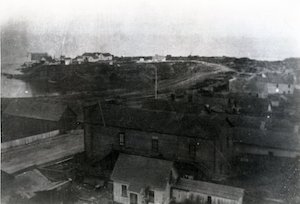
Early view of Mendocino looking southwest along Main Street toward the Shipping Point with stacks of lumber waiting to be loaded. The small white dwelling in the foreground is a Chinese dwelling, and is behind the Chung Kow Wash House, which is not visible to the left. A total of three Chinese buildings are on this one lot, according to the 1894 Sanborn map. This lot was developed in the early 1900s into the Bank of America building (Out of This World in 2022) and Granskog’s store and garage farther west.
The 2-story building with the outside steps (behind the white house) was originally J. D. Murray’s drugstore with the stairs leading up to Murray’s Hall. By 1894, his widow, Theresa Flanagan Murray, had moved the business down Main Street. This building then became a variety store, and then a saloon. Eugene Brown’s House is on the other side of it.
Murray’s Hall was torn down in 1935. The Beacon reminisced, “Murray’s Hall was the scene of many a festive social gathering of the old days and many local plays were put on there. People came from all parts of the coast to attend some of the more prominent functions held there, and the older residents can recall many good times there. Some of them attended their first public Christmas tree there while others made their first appearance in amateur theatricals on its old-time stage. It was many times used for rousing political meetings where the crowd assembled after the customary torchlight procession. And it served as a courtroom on one or more occasions where the preliminary hearing of a suspected murderer was held.”
The long building across Main Street is a blacksmith and wagon shop built in 1885 by T. W. LeBallister. “Chinatown” begins to the right of that building, going west on Main Street. (Kelley House Collection, Kelley House Photographs)
Look Tin Eli: The Mendocino Visionary Who Helped Shape the Chinese-American Experience by Robert S. Becker and Jane Tillis – The life of Mendocino-born visionary Look Tin Eli was one of national significance. As a teenager returning home from China in 1884, his illegal detention instigated a court battle, culminating in the state’s legal precedent granting full citizenship for all native-born Californians. After the 1906 earthquake in San Francisco, he was instrumental in establishing Chinatown as a business center and tourist destination. He founded the first Chinese-owned bank, the Canton Bank of San Francisco, and he started the China Mail steamship company. With almost fifty historic images, this first book-length profile of Look Tin Eli brings to life the cultural and commercial achievements of this remarkable trailblazer. $25.